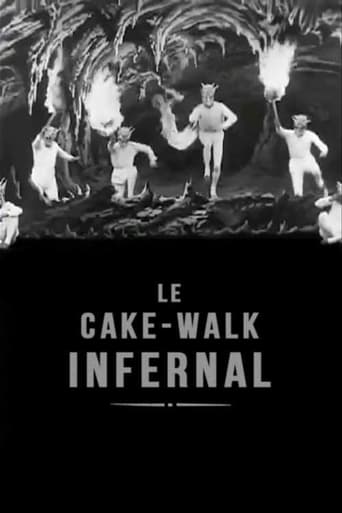framptonhollis
Melies made hundreds upon hundreds of short films; some of them masterpiece,s others mediocre, many falling somewhere in between. It can be proposed that "The Cake-Walk Infernal" is among his better known works (that is casting aside legendary films like "A Trip to the Moon", "The Voyage Across the Impossible ", or even "The Merry Frolics of Satan"), mainly because of Martin Scorsese's recommendation of it for aspiring filmmakers/film students. This film is just simple, classic Melies with an extra dose of weird. It mostly consists of a parodic version of a dance that seems to have been popular at the time of the film's release; it takes place in Hell, despite the merry mood, and Melies himself plays a reasonably athletic Satan. The visual effects here are quite phenomenal, particularly for 1903 (!), and the sets, while sort of cheesy, are charming and appealing to the eye. There are also plenty of laughs to be had, mainly because of Melies' comic and over the top performance and the trick photography that soon ensues. Those that are rather familiar with Melies and his style will likely be able to appreciate this for what it is: another unique and wild entry in the vast Melies cannon.
thinbeach
What does a Melies musical look like? Well with painted sets, bursts of smoke, a few trick camera shots and the appearance of demons, unsurprisingly it looks like most his other films, only here the tricks will not impress anyone already familiar with Melies skills, and there is no story, so that what we are left is basically 5 minutes of what is some pretty uninspiring dancing.I notice a reviewer above me cited this film as a parody of a popular dance at the time. Of course, more than 100 years on, this context is completely lost, and there is not a laugh to be had. Why Melies felt like making a film that danced to the devil is open to interpretation, but there was certainly no enjoyment in it here.
Snow Leopard
Although the original motivation behind this Georges Méliès feature was to spoof a popular dance craze of the day, it has so much of Méliès's wit and camera wizardry that it is still quite funny and entertaining today. This kind of popular culture parody is just one of the many genres to which Méliès applied his extraordinary imagination.The feature takes the "Cake-Walk" dance and uses it is the subject for a series of short dance numbers, some of which would almost look at home in an MGM musical, and others of which are enjoyably bizarre. The backgrounds are stage-like, but they usually contain plenty of interesting detail in themselves. Some of the sequences feature amusing sights without any camera tricks, while at other times Méliès demonstrates the special effects for which he was so well-known.There isn't really a story so much as a succession of images, which yet somehow seem connected by a strange logic all their own. There are so many unusual and skillful Méliès movies that it gets awkward to say of all of them that, "any fan of Méliès would enjoy this", but in this case it is once again true.
bob the moo
Do they dance in Hell? If they do then this is maybe what it is like. We join the scene of naïve celebration among the dancers when a demon bursts through onto the scene to torment the only black dancer with a version of the cake-walk that has the fires of damnation behind it.Back when many films were very descriptive and very 'real' in their subjects, Méliès must have been a bewildering influence. Films called 'man riding a horse' were wowing them in the moving pictures (or movies as they are still called) by doing exactly what they said on the tin, or in other words, such a film would feature a man on a horse, a training coming into a station and so on. Méliès created short films that contain visual images that still retain their appeal today and will be known to many people (even if they don't know that they are his images!) and this is the modern appeal of his films to me. Sure they are simple in terms of substance and are more style over content but remember these are a century old – think of how they must have been viewed then!This is one example but it is not one of his best for my money. The film is weird even watching it now and it is far more about visual impact than about its narrative foundation or substance. It looks great and some of the effects show him to have been years ahead of his time – anyone looking for meaning or plot will be annoyed but the focus is visuals and, in this regard, it still works and is very imaginative and strange.I have watched many rubbish films and many good films that have lasted two hours; this film lasts only a very minutes and is well worth the amount of time it took for me to watch it. Méliès' images are still in the public psyche today and this film, while not his most famous, is another good example of why that is the case.
